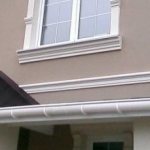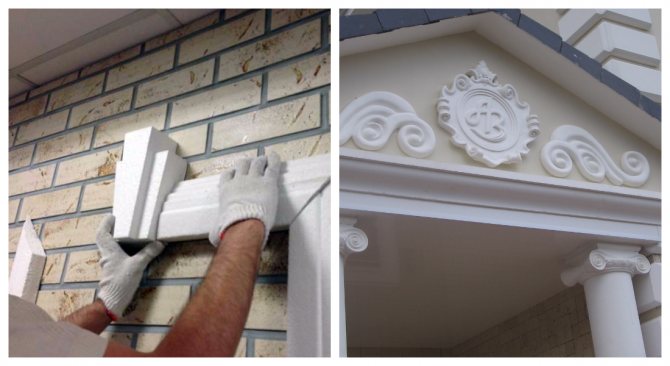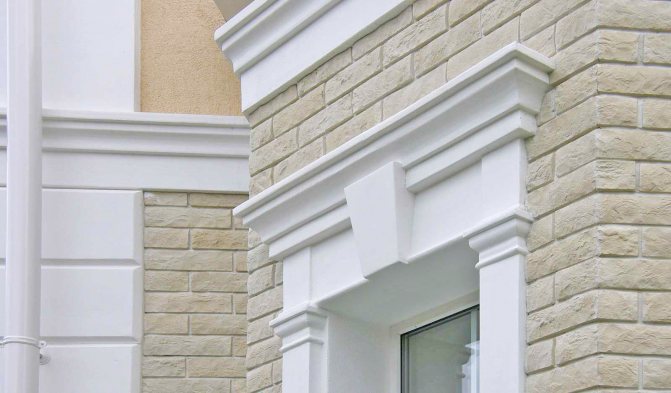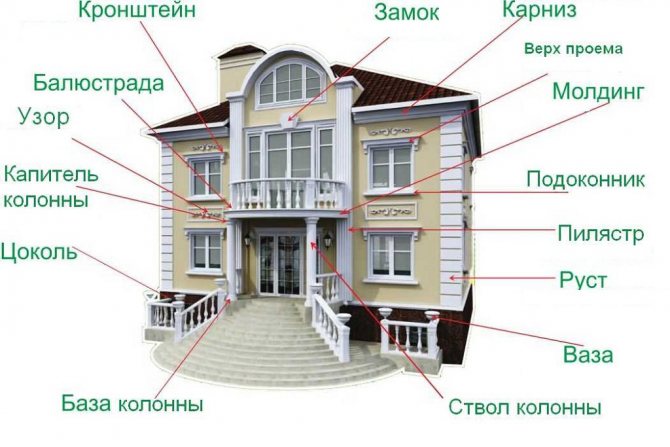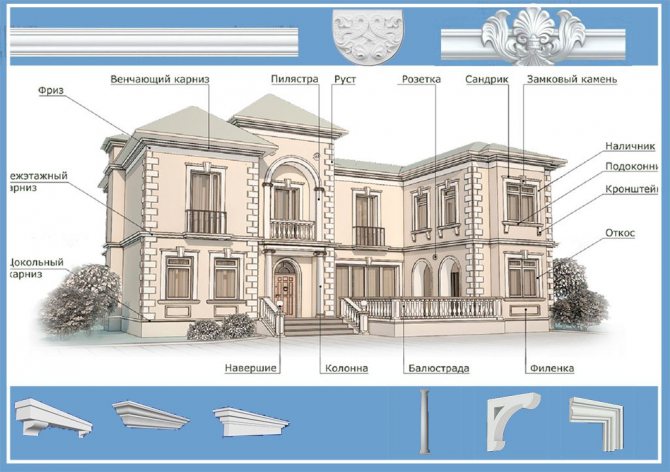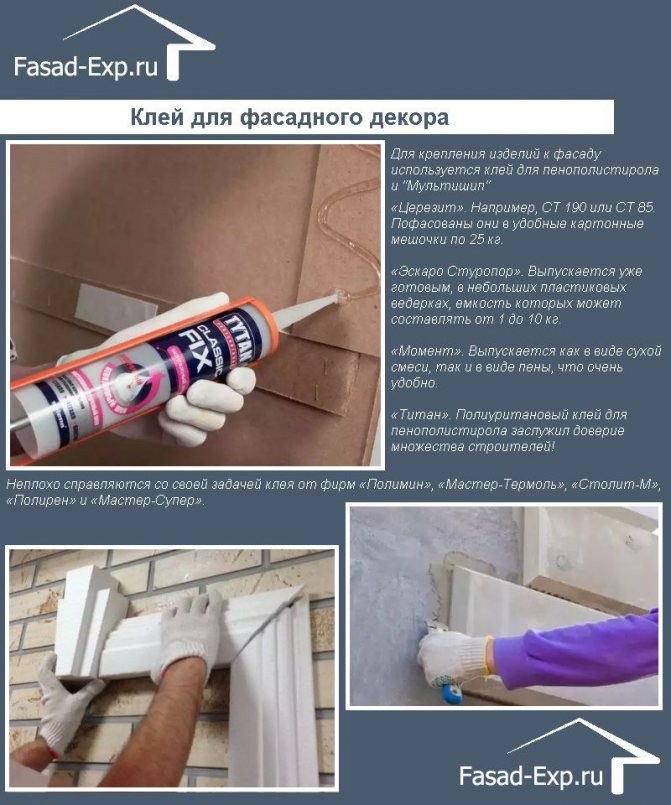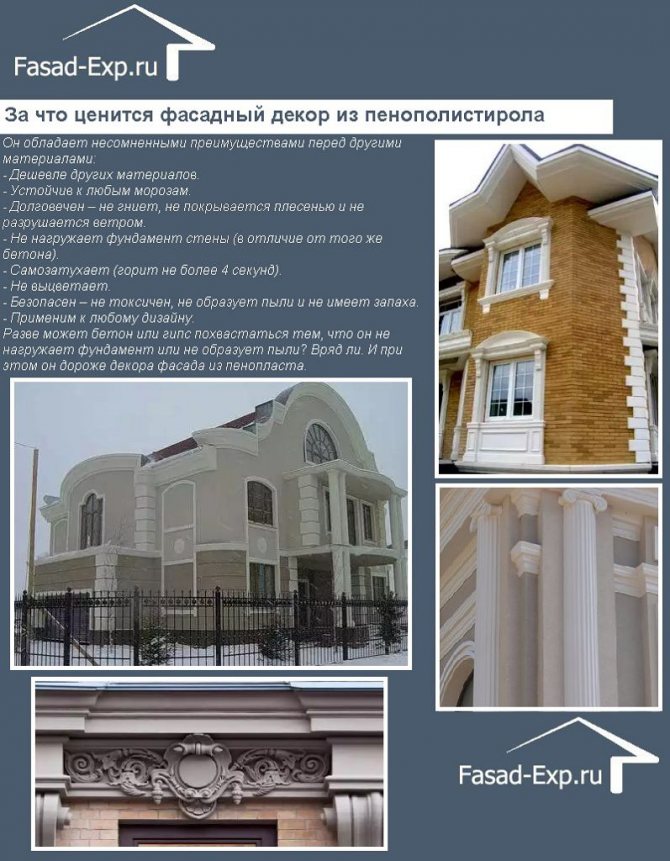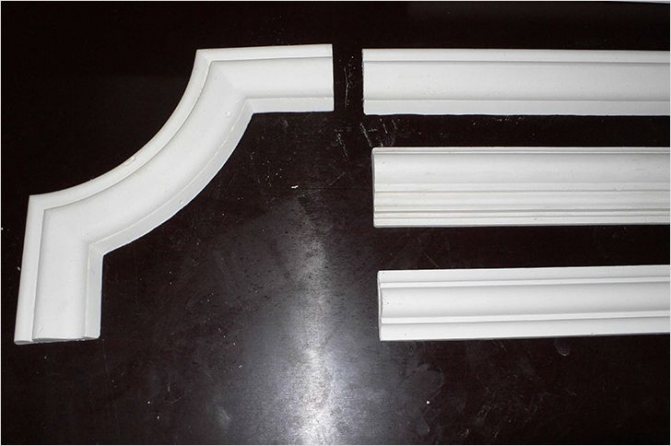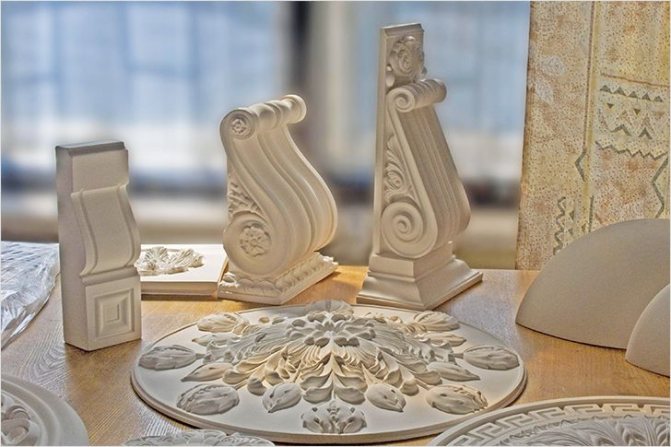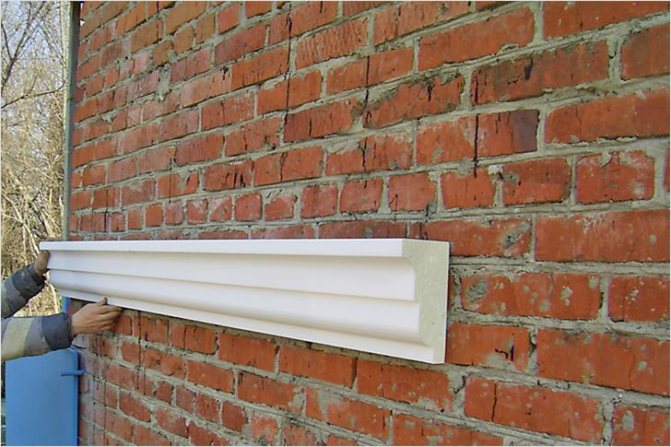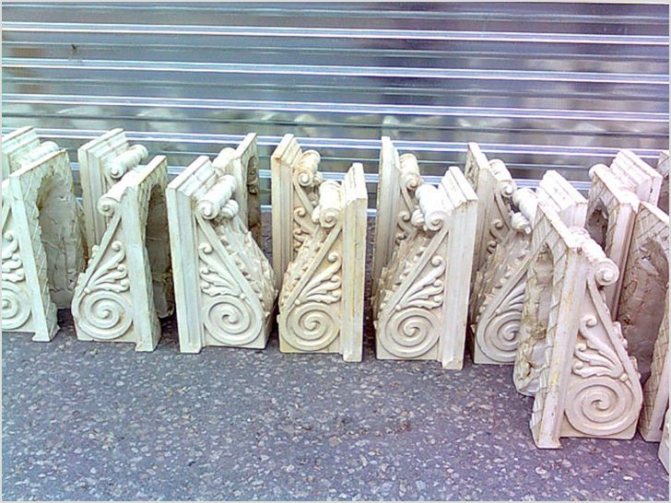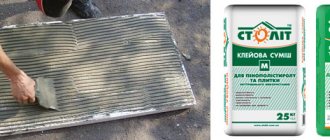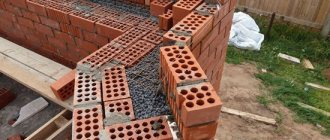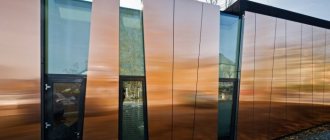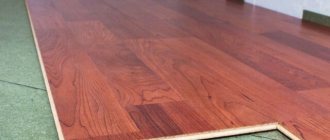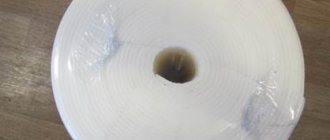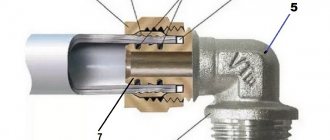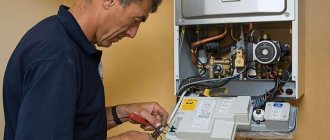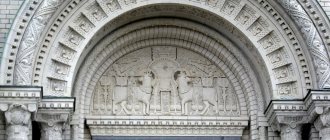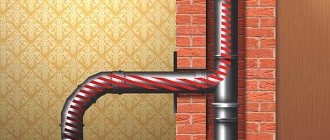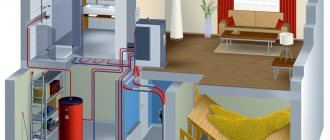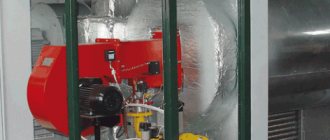Updated:
2019-08-15
Not everyone decides to make a facade decor made of polystyrene for one reason or another. Many people underestimate the possibilities and benefits of this option for decorating the exterior walls of the house. Therefore, this material will be devoted to telling in detail about the nuances, advantages and features of the facade decor made of foam.
What are the advantages of the material
Polyfoam is a versatile polymer material that is widely used for various purposes. Most often, this term is called polystyrene foam and polyurethane foam plates. Polyfoam has a number of positive qualities: light weight, ease of cutting, thermal insulation properties, whiteness, rather low cost.
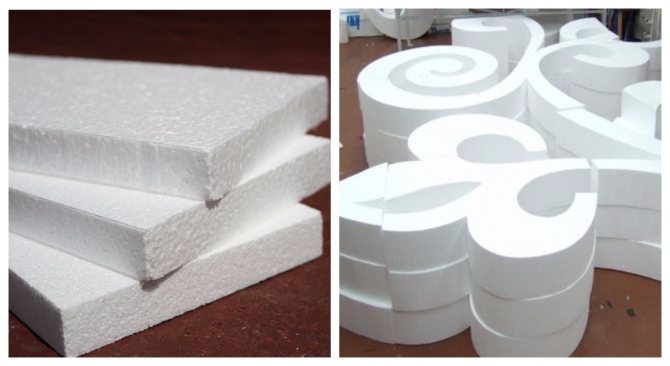
Styrofoam - light, warm, inexpensive - excellent material for decoration
This material has different density and grain size. Dense structures can be easily confused with gypsum and natural stone, even marble. This effect is the basis for the use of foam as decorative elements. The ease of processing of the material makes it possible to manufacture any figures, patterned carvings and other products. Styrofoam molding in appearance is almost indistinguishable from gypsum creations, while it is lightweight and easy to manufacture.
Along with the positive qualities, the material also has one important drawback. This polymer (especially expanded polystyrene) has a low melting and ignition temperature, and when it burns and simply exposed to high temperatures, it can release substances harmful to humans. This condition is important to consider when using it. In addition, the foam breaks easily, and therefore should not be subjected to mechanical stress.
When the facade is being set up, foam plastic can be used in several grades: PSB-S-15, PSB-S-25 and PSB-S-35. The last type of material (which is the most expensive) is considered the most durable, so it is used in harsh climatic conditions. The most widespread is PSB-S-25 foam, which has a density of 20–25 kg / m³, and the permissible bending load is no more than 0.26 MPa. It is also important that the water absorption of the material is practically 0.
Material capabilities
Firstly, the possibility of using finishing material for decorating a private house. Numerous elements are shown on the façade of a large two-story building. However, this does not mean that styrofoam facade decor can only be used on mansions. In any building, you can install individual elements or other details, including those of an exclusive nature.
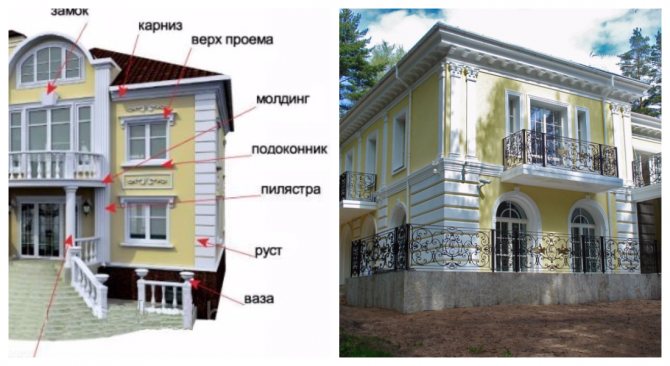

Styrofoam will help to embody any ideas for indoor and outdoor decoration
The following are the most common styrofoam decorative elements for the facade:
- moldings;
- cornices;
- rusty;
- columns;
- pilasters.
When performing them, different techniques can be used:
- stucco molding;
- bas-reliefs;
- thread;
- ornaments;
- patterns;
- vases;
- flowerpots, etc.
Secondly, the cladding can be made of standard parts, exclusive items purchased ready-made or made by hand.
Finishing the facade of a house with foam plastic can include the following solutions:
- threaded styrofoam cornice;
- porticoes;
- architectural modilions;
- rustication of the basement or the entire corner of the building;
- carved foam window frames;
- console elements;
- portals and flutes.
Third, facade decorative foam has the following advantages:
- fairly quick and easy production of parts;
- low cost;
- high service life;
- no size limitation;
- the ability to carry out work independently;
- absence of significant additional mechanical loads on the wall and foundation, taking into account the low specific weight of plastic;
- fairly high compressive strength;
- no risk of rotting and mold;
- high resistance to any climatic conditions in all regions of the country;
- long-term color retention.
Types of styrofoam molding
Stucco molding can imitate Greek, Roman, Egyptian, oriental, baroque, classicism. The ornament can decorate a detail in whole or in part. It can be simple and complex. Usually they use various geometric shapes, straight lines, points, zigzags, crosses, stars, waves.
Popular patterns include numerous floral ornaments (rose, lotus, ivy), images of mythical animals and birds, figures and faces of people, signs, emblems, seals. Various inscriptions are also used.
Types of stucco decoration in room decoration:
- pilasters;
- columns;
- half columns;
- arches;
- moldings;
- capitals;
- bas-reliefs and panels;
- panels;
- modons;
- rusty;
- sandriks;
- sockets;
- simple and threaded cornices;
- platbands;
- consoles;
- window sills;
- portals and flutes.
What is required for decoration
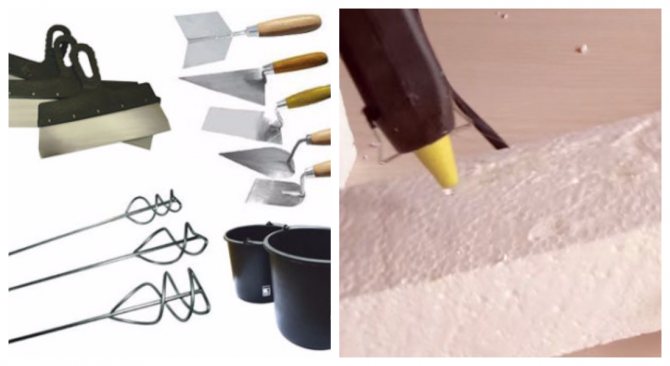

For decorating with foam, you will need a set of tools and additional materials
In order to equip a foam plastic facade, you should take care of such consumables and accessories in advance:
- polyurethane-based polyurethane foam;
- foam glue;
- dowels 12–20 cm long, umbrella type;
- reinforced fiberglass mesh;
- acrylic type putty;
- facade primer composition;
- paint for facade works;
- mineral plaster.
Such a tool will help to carry out all the work qualitatively:
- glue gun;
- "String" for cutting foam;
- knife;
- jigsaw;
- hacksaw for metal;
- putty knife;
- paint brush;
- construction mixer;
- electric drill;
- screwdriver;
- plumb line;
- roulette;
- metal ruler;
- protractor;
- building level.
Technological stages
Styrofoam facade decoration, although it is considered a fairly simple event available to any person, is carried out in several stages, taking into account certain principles.
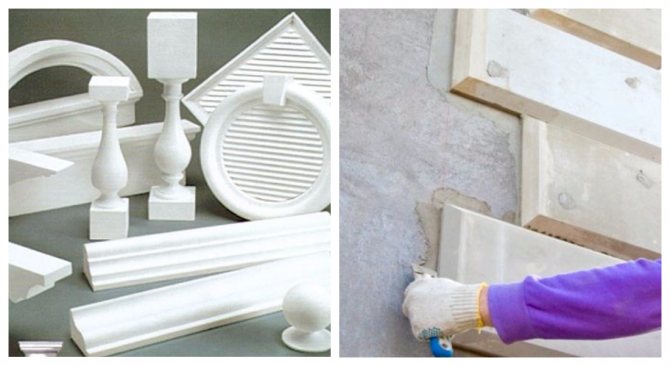

Styrofoam decor is a simple task, the main thing is to observe the phasing
The following main stages are distinguished:
- preparatory work;
- making or purchasing decoration elements;
- leveling the surface;
- installation of polystyrene with its reliable fixing in the right place;
- application of protective and finishing coatings.
The preparatory phase begins with the development of a project for the overall design of the facade. At this stage, the style of decoration and the number, type and size of decorative elements are determined; a diagram of their placement is drawn. Next, a thorough preparation of the surface is carried out for the application of foam:
- leveling the surface;
- cleaning the installation site from dirt and grease.
Installation of foam decor includes the following processes:
- Alignment of the facade structure on which the decor is planned to be installed. As a rule, such areas include cornices, window sills, certain zones on the wall, jambs of window and door openings. Leveling is carried out by applying plaster.
- Installation of decor. The facade foam is attached with a special glue designed specifically for this material. In particular, you can about. The adhesive is applied to the entire back side of the part, and then it is pressed against the installation site and held until it is adhered with glue. When installing large parts or in cases where they protrude above the wall surface by more than 10–12 cm, the fastening is reinforced with dowels or anchors. For their installation, holes are carefully drilled in the foam.If such a need arises after installation, then drilling is carried out after the glue has completely hardened (2-3 days). In the appropriate places on the wall, the filling elements are installed. When mounting parts vertically on a wall, it is recommended to keep them pressed for 30–40 hours.
- Sealing joints and seams. This operation is carried out using special facade sealants, which are applied with a facade brush. After the composition has dried, grouting is carried out. Merolith S1 can be recommended as such a sealant.
- When a facade decor made of coated foam is provided, a number of additional work is carried out. A thin layer of primer is applied to the surface of the plastic. After hardening and grinding, the facade elements are covered with acrylic paint in 2 layers.
Installation of foam decor
Almost every one of you is capable of mounting foam decorative elements. It is not necessary to have a lot of experience for DIY finishing to give an excellent result.
We suggest that you familiarize yourself with the instructions that will allow you to turn an ordinary foam sheet into an amazing result for the outer walls of your home.
- The surface of the walls must be cleaned of building materials, mold, dirt. It is best to do this work mechanically, although in some situations it is more relevant to use special solutions.
- Ensure that the installation is carried out on clean, level and dry surfaces. So the finishing of the facade with polystyrene will turn out to be really high-quality. If the deviation from the plane is more than 10 millimeters per 1m2, the wall surfaces are leveled.
- If the facade is covered with paints, they should be mechanically exfoliated.
- Installation is carried out on the surface of the walls in sequence, using a special glue for foam plastic to glue the products. But foam glue does not always allow you to cope with all parts of the facade. In some cases, foam glue is combined using anchor pieces and embedded fasteners. It is not recommended to use only fasteners. Glue acts as an obligatory element of installation, since it ensures a tight fit of the foam decor to the wall surfaces, levels the gaps.
- The glue should be applied to the entire decorative PSB sheet, and then firmly press the foam plastic for the facade in the desired position.
- You should hold the decor for some time until the glue adheres to the surface of the walls.
- If necessary, additional installation with dowels is performed. But you can only drill holes for them when the glue is completely dry.
- After finishing the installation, fill the holes for the dowels, as well as the joints between the sheets and decorative elements with appropriate sealants. Layers of sealant will provide additional strength and protection of the walls themselves from external influences.
Styrofoam finishing
At this point, the work cannot be considered completed yet. So far, the sheet looks just like a blank. Leaving the facade in this form is not worth it, since outwardly it will not look the best way.
You need to paint the styrofoam decor. The final stage in the decoration of the walls of the facade with foam plastic is to paint it. For this:
- Apply a special primer to the foam. Make sure the primer is suitable for handling the styrofoam;
- Wait until the primer is completely dry on the surface of the foam decor;
- Apply the first coat of paint to the walls. For this, it is recommended to use acrylic paints;
- Wait until the first layer of paint on the foam is dry;
- Apply a second coat of acrylic paint to your styrofoam façade decor.
As practice shows, two layers of paint when decorating the facade of a house made of polystyrene is quite enough.Coated styrofoam façade decor significantly improves the technical and protective characteristics of the finish. Now the work on installing the foam on the facade can really be considered complete. The walls are finished with styrofoam elements, primed and painted. Enjoy the result.
Styrofoam decoration
The production of shaped elements from polystyrene, first of all, provides for its accurate cutting. During such a procedure, crumbling of the material must not be allowed. That is why its cutting is provided by a heated "string". If the composition is composed of several parts, then the accuracy of their alignment should not exceed 1 mm.
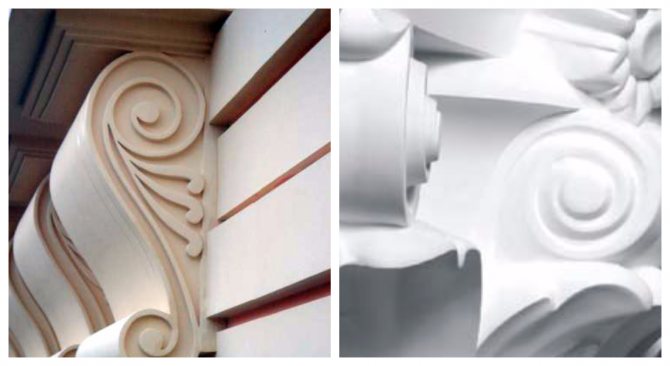

Use a heated string to get neatly cut pieces.
In general, the production of decorative foam elements is carried out in the following order:
- Decoration of a decor sketch or selection of a ready-made idea with a drawing of all the details, methods of their articulation, attachment points, a choice of colors.
- Drawing the element on foam in full size, and so that you can cut the material.
- Cutting out the conceived shape from the styrofoam.
- Strengthening the decoration element. For this purpose, a fiberglass mesh is fixed using an adhesive composition applied by spraying with the formation of a layer with a thickness of about 2–2.5 mm.
Foam molding
Facade moldings are usually made of plaster and are considered a very common decorative element. Recently, styrofoam molding has become a worthy competitor to such parts. It is lightweight so it can be easily attached to the wall. The facade of a house with a similar decor looks no worse than with a classic design.
Foam stucco molding perfectly replaces gypsum, both in time and in financial costs
Of course, the facade stucco molding is more difficult to manufacture, since it is a volumetric figure. It is best to use finished products that are manufactured by pressing in the factory. However, you can do it yourself, but for this you should use the densest foam - PSB-S-35. Shapes such as curls, voluminous flowers, bas-reliefs, etc. are cut from it.
Decorating the facade of a house with foam plastic has gained wide popularity. The ease of manufacture and installation allows you to do everything yourself, while the decor is difficult to distinguish from the classic options - gypsum, natural stone.
Styrofoam facade decor has an attractive cost. In addition, such products have an original appearance.
Decorative elements, despite their low cost, are not inferior to decor made from other building materials in terms of their reliability, durability, and durability.
Buy decorative beams AMARO
Experience the beauty and elegance of our wood grain beams. Short lead times and quality will pleasantly surprise you.
Order form for beams, boards, glue, belts
Using this form, you can send an application-order for any kind of decorative beams or boards made of polyurethane foam, decorative belts, consoles, glue, paint, etc. After the order has been processed by our sales department, the staff will contact you to clarify the order parameters, delivery times, delivery conditions, etc.
Distinctive features of styrofoam decoration
Styrofoam decorations for the facade are made by pouring into special molds.
Attention! When installing foam products on the facade of the house, you must use a special protective coating.
It is necessary to increase the resistance of foam products to external negative actions, increase its strength, and extend the service life.
There are many reasons why ordinary buyers should buy styrofoam decorative items.
Facade decor elements are offered by manufacturers in a different color range, moreover, at quite affordable prices.
Polyfoam does not have high reliability, mechanical resistance, durability, but with the help of modern technologies, all these minor disadvantages can be easily eliminated.
Advice! Facade decor made of expanded polystyrene (polystyrene) without additional processing is appropriate only in places that are reliably protected from the environment.
For example, you can use foam facade elements to decorate the cornice, which is located under the roof slope. This area is reliably protected from moisture penetration, besides, the material is not threatened with mechanical damage.
The facade decor made of foam plastic, made in the form of arches, must be processed so that weather conditions do not spoil its appearance. Sometimes decorative elements made of expanded polystyrene are used in conjunction with other materials that will allow the decoration to be used much longer.
Among the fashion trends of recent times, we note the option of non-standard decoration of the external walls of a private house.
Styrofoam decor for the facade is lightweight, easy to process, so the material is in demand among architects. It is the styrofoam decor that makes it possible for the owners of country cottages to embody original design ideas into reality.
Finishing the facade of the house with decorative elements
What are the decorative components of the facade and why should they be used in architecture and decoration. This question does not arise when you see the old buildings of Moscow, Venice or St. Petersburg. The beauty and uniqueness of the finish attracts, you want to touch it. Such buildings are remembered for a long time. All this happens thanks to the decorative elements.
Various arches, rusts, capitals, columns, platbands, balusters, rosettes and much more make the image of the building complete. The house gets its own face. Looking at old buildings, we often do not think about what all this is made of, and we are quite sure that it is impossible to do this on the walls of our own home, but it is not.
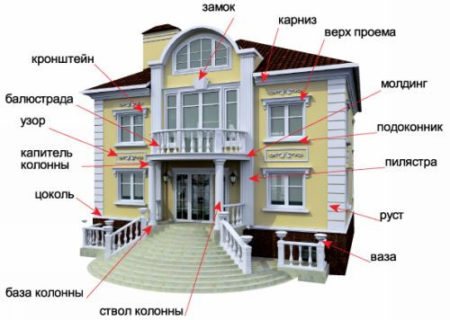

Facade decor
Stucco
The word stucco molding causes a grimace of rejection in many. For most of us, it means something ancient, necessarily white, and definitely not suitable for a modern home. What is it really. Exquisite details and subtle reliefs on the facade can only be made by facade stucco molding. Previously, it was made from plaster. This is an environmentally friendly material that allows you to make facade decor right on the spot or cast it in ready-made forms. But it also has disadvantages. First of all, it's weight. The gypsum parts are very heavy and put a significant strain on the building. The installation of such decorations is difficult, which is why in the old days, many large decorative elements were performed directly on the facade. In addition, gypsum degrades over time under the influence of atmospheric changes.
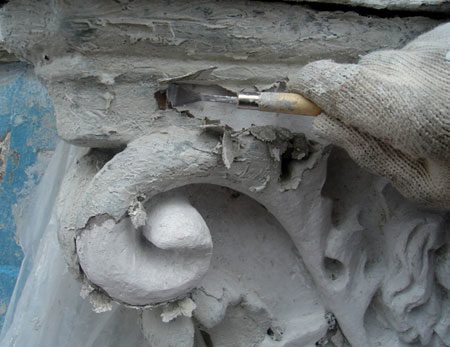

Restoration of plaster moldings
Yes, gypsum stucco molding can give the building a chic look, but today gypsum has been replaced with stronger and lighter materials that are not inferior in beauty to gypsum. Polymer concrete combines the strength of concrete, but it is ten times lighter. Installation of these products is simple even with your own hands, and in aesthetics they are not inferior to plaster. The peculiarity of the composition is that it can imitate various structures, for example, granite and marble. The photo shows how polymer concrete imitates old stucco molding.
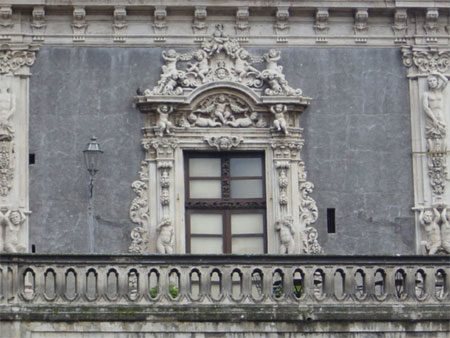

Window decoration with polymer concrete
An interesting and very popular building composition for decorating a house is glass fiber concrete or fiber concrete. It is made from dry building mixtures with fiberglass additives. Its strength and lightness make it possible to make columns and other supporting architectural elements from it.Many multi-storey buildings in Moscow are finished with glass fiber concrete.
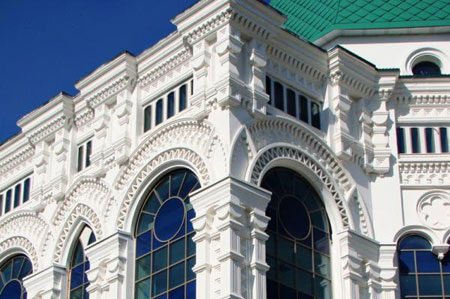

GRC stucco molding
Polyurethane decor
A new structural element that has conquered its niche in the decoration of private houses is polyurethane. Lightweight, durable, wear-resistant material that is easy to assemble with your own hands, just a special glue. Polyurethane belongs to the mid-price category of facade decor, but its quality is worth spending. After all, polyurethane is not only durable, but also elastic, so the facade elements from it do not deform or delaminate.
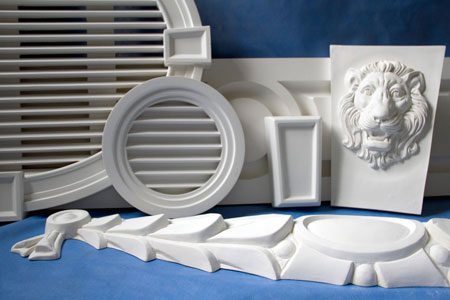

Polyurethane stucco molding
Styrofoam and styrofoam decor
One of the most popular textures for decorative facades is polystyrene and expanded polystyrene. Lightweight, not affected by atmospheric precipitation, frost-resistant and indifferent to all types of fungus, it has several more qualities, due to which the front parts come out much cheaper than the previous ones.
Facade decor made of polystyrene and expanded polystyrene is made using non-molding technology, and therefore expensive forms are not needed for its production. For manufacturing, a string cutting mechanism with digital computer control is used. The dimensions of the finishing components are unlimited, since it weighs almost nothing. The surface of the foam elements is reinforced with an acrylic fiberglass mesh on which a cement-glue coating is applied. After all the manipulations, the product resembles a plastered surface.
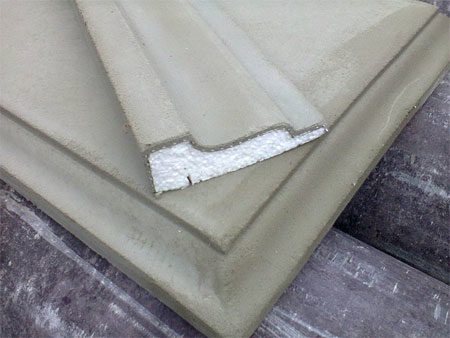

Facade decor from expanded polystyrene in section
Fiberglass decor
A durable and effective replacement for concrete, polyurethane and foam is fiberglass or fiberglass. Not only decorative elements are made from it, but also facade panels. Fiberglass composite does not deform, does not corrode, is resistant to any temperature, but at the same time is very light.
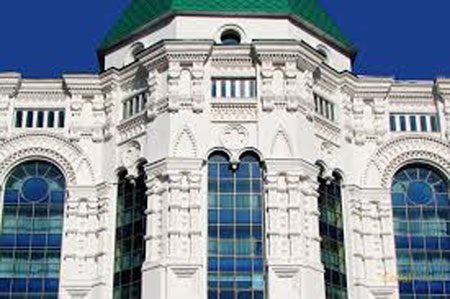

Glass composite facade
Original ideas for decor
Styrofoam facade decor is a way to add some romantic warmth to a building.
Advice! If you complete the upper part of the residential building with a foam decorative entablature, add decorative columns to it, the house will become a real castle.
Such a house, decorated with figured decor made of polymer material, will become your pride in front of guests. Decorative chips applied to the facade decor made of expanded polystyrene can make your home more original.
Among those architectural elements that can be made of foam, we highlight:
- moldings;
- carved cornices;
- fragments of the console;
- modillons;
- decoration of the basement of the house
Installation recommendations
Styrofoam decor is easy to install, all work can be done independently. It is important to fulfill some requirements.
Finishing work is carried out at a temperature above +15. It is important to decide on the style of the facade design, prepare a sketch. The location of the decor must be selected in advance, the number of required decorative elements must be calculated. Buy the necessary supplies and tools:
- spatulas;
- glue;
- paint;
- putty;
- primer;
- sealant.
It is necessary to prepare the surface of the building well: walls must be dry, clean and level. Fill up all cracks and irregularities, remove dirt. A primer is applied to the finished flat surface. Markings are drawn on the facade so that you can see where to place the parts.
When all the preparatory work is completed, you can proceed with the installation. The stucco molding is adjusted to the required size, a special adhesive is applied and the decor is attached to the facade. Large elements must be additionally secured with dowels. After all the parts are glued, the seams between them are filled with sealant and cleaned.
Distinctive characteristics of foam decorative elements
The decor of the facade of the house made of foam plastic has some distinctive characteristics:
- affordable price of products;
- ease and speed of installation of finished products;
- the ability to decorate without the involvement of specialists;
- minimum weight that does not lead to additional load on the foundation of the building;
- long operational life;
- excellent moisture-repellent characteristics;
- increased strength;
- environmental friendliness and resistance to decay processes
Installation work associated with the use of polymer makes it possible to carry out installation in any climatic conditions, regardless of temperature indicators.
Installation of decor on the facade of the house
When carrying out such work, you must follow the algorithm of actions. First, you need to carry out preparatory work with the surface on which the decor will be attached. To do this, remove the remnants of old plaster from the surface, remove dust and dirt. Armed with facade plaster, it is important to eliminate all internal irregularities.
Advice! If voids are identified, cement mortar can be used to level them.
Then, they designate the places where the decorative facade elements will be attached. If some elements of the product will protrude by 10-15 centimeters, you will have to strengthen the structure with dowels driven into the walls of the house in advance. Before starting work related to the design of a foam plastic facade, professionals recommend checking the evenness of the surface.
The next stage of the installation work will be the dilution of the glue, applying it to the back of the decorative fragments
When attaching them to the wall, a little effort is required to improve the quality of adhesion of the adhesive to the surface to be formed.
Attention! Be careful when working with decorative fragments, as the product is fragile.
The installation process is completed by sealing the fastener gaps with polyurethane foam or sealant. After it is completely dry, you can remove the remains with a spatula.
Further, a high-quality priming of all decorative elements is carried out using a special solution. At the final stage, the polymer decor is painted with acrylic dyes according to the design project. To increase the service life of products, professionals recommend painting 2-3 times.
Applying additional protection to the facade decor is an obligatory stage of finishing work. This will protect the finished product from sudden temperature changes and high humidity.
Features of the manufacture of foam decor
There are stringent requirements for the polymer that is made for the facade decoration of houses. The material for production is PSB 25f. It has all the most important characteristics and qualities in order to be used in exterior wall decoration. Thanks to modern automatic equipment, you can burn and cut contours, create products of different sizes and shapes. In order to achieve reliable protection of the created element from high humidity, sharp temperature jumps, sheets of polymer material are covered with a reinforcing compound. For example, you can treat a sheet blank made of polymer material with mineral mixtures based on acrylic paint.
Next, the sheet is sent to drying. In order for the polymer not to lose its technical and operational characteristics, it is necessary to withstand a certain temperature regime. As soon as the protective layer dries up, the workpiece is sent to the last stage of production: cleaning and polishing.
Pros of expanded polystyrene:
- the use of facade foam in the exterior decoration protects the building from weather influences;
- foam trim provides additional sound insulation for the building;
- facade decor made of foam acts as an external insulation, which reduces the cost of heating the building;
- ease of handling foam allows you to make facade elements of any shape;
- the composition of the facade expanded polystyrene does not have a negative impact on the ecology of the environment;
- the light weight of the material reduces the stress on the building.
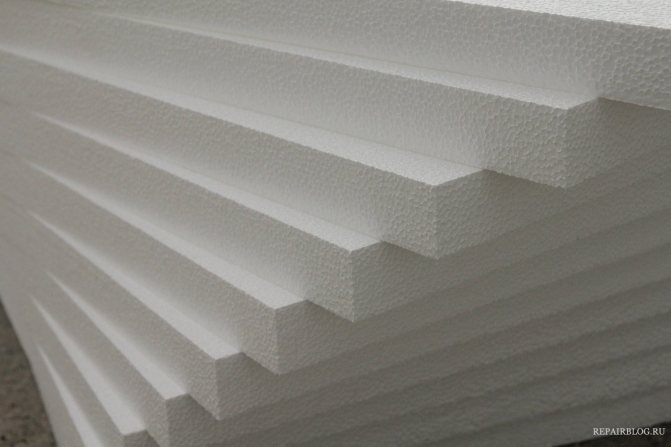

Expanded polystyrene
How to make styrofoam decor by hand
Returning to the issue of making facade decor with our own hands, let's consider the technical and practical aspects of the foam products themselves and the most frequently asked questions on this topic:
- how to make styrofoam decor
- do-it-yourself styrofoam platbands
- DIY styrofoam crafts
- do-it-yourself curly cutting of polystyrene
The main criterion for making a decision to buy ready-made facade products or to give an assignment to facades - those who insulate your house is the geometric shape of the elements that you want to apply on the facade of the house. You have probably seen very often the facades of houses with simple frames around the windows and with two or three stepped eaves under the eaves of the roof. Simple rectangular rustic stones are also often found at the corners of the house. This kind of facade decor is made manually by the performers of the facade work when the facade is insulated.
The simple rectangular shape of the decor elements allows you to make them yourself right on the spot. The elements, like the wall of the house, are reinforced according to the usual technology of reinforcing the insulation on the facade - glue, mesh. The corners of the parts are additionally reinforced with special corners. It's another matter if you want to apply details of architectural decor of complex geometric shapes. Rounds, waves, many steps, bulges - such details are the difference between the imitation of architectural elements from their real application on the facade of the house.
The complexity of the geometry of the products does not allow manual reinforcement of the foam plastic with a protective layer. Therefore, in this case, there is one correct solution - it is to buy ready-made elements of facade decor from the manufacturer.
Houses of the same type are a thing of the past: moreover, this applies not only to private buildings, but also to multi-storey buildings. People want their homes to be unique and special. To create a unique exterior of the building, foam plastic facade decor is used: you can create a real masterpiece with your own hands.
The positive properties of the material made it popular:
- affordable cost,
- a light weight,
- resistance to temperature extremes and ultraviolet light,
- moisture resistance.
This decor will last a long time without losing its original appeal.
Until recently, facade elements for decoration were made exclusively of concrete and plaster. Such decorations were very heavy and quickly deteriorated from high humidity. In addition, concrete and plaster parts increased the load on the supporting elements of the structure, so sometimes such heavy decorations had to be abandoned.
Modern designers use lighter materials for facades. Facade decor made of expanded polystyrene is characterized by ease of installation and durability. Unlike wooden and plaster structures, the material is not afraid of moisture. Compared to stone products, foam is lightweight. By choosing the desired shade in a wide range of colors, you can favorably set off the main color of the building or choose a contrasting finish.
- The indisputable advantage of expanded polystyrene is resistance to alkalis, water, acid, mineral oil.
- The material is easy to cut, glue with mastic, plaster or cement mortar. Even a novice master can do the decor of the facade on his own.
- The material does not contain hazardous chemical compounds and does not burn, and also has good compressive strength.
- All decorative elements that will be made of polystyrene are odorless and are not subject to decay or mold.
- Due to its low weight, the stucco molding is quite easy to fix.
Taking into account a number of the listed advantages, our company offers the production of foam decor.Decorative elements are used not only for exterior decoration, but also for interior decoration. Also, expanded polystyrene is useful for the restoration of old structures. Facade decoration elements are used to improve the appearance of the building, style. Also, finishing elements will protect sections of the structure from climatic influences. Facade elements increase the thermal insulation of the building, improve sound insulation and increase the service life of the building.
How to make styrofoam decor with your own hands
Foam molding can be used for self-assembly. Many architectural elements will help make your home beautiful: windows, window sills, gables, cornice, pilasters, balustrades. Each element of the facade is treated with a special coating, so we can confidently talk about the resistance of the material to external influences. Small decorative elements can change the exterior of the building beyond recognition.
Manufacturing and installation stages:
- Parts are cut by thermal contour cutting using a hot wire. In an industrial environment, you can pre-program the shape of the product, and perform cutting on a computer machine with maximum accuracy.
- After applying the reinforcing layer, the contact of the foam with the external environment ceases. The detail for the facade decoration is covered with a fiberglass mesh, which protects against alkalis.
- Next, a deep penetration cement-glue mixture is applied, which forms a film with a thickness of about one and a half millimeters. After such processing, the parts become resistant to ultraviolet light and cease to attract dust. The film is a good base for painting.
Since the facade decor can imitate natural materials, it can be used to decorate various areas of the building. The variety of topcoats allows owners to choose an imitation of stone, wood, plaster, marble. Foam facing stones are used in corner areas. Outwardly, they are no different from granite or marble. Due to the protrusions relative to the walls, a beautiful relief is formed.
Since the installation of the decor is not particularly difficult, it is often done independently.
In order for the material to last a long time, you should know the important norms and rules of work when installing foam decor with your own hands:
- At the place where the decor is installed, the surface is cleaned of dirt, mortar, and mold. This can be done using mechanical means or chemicals. Ideally, the mounting base should be flat and clean, completely dry.
- If the surface has deviations from the plane, then it should be leveled.
- Check old plaster for voids: they are removed before installation.
- After preparing the base and marking, the material is fixed with an adhesive mixture, the glue must be used, since it gives the foam plastic adhesion to the supporting structure. Excess uncured glue is removed with a spatula. The joints of the decor and the base are glued with a compound for seams.
- Then they are additionally fixed with dowels with drowning of the caps by three to four millimeters. Depending on the weight, size and type of product, embedded parts and anchoring devices can be used.
The use of various mounting techniques allows you to create optical effects of the masonry: horizontal and vertical directions, offset, diagonal. The arrangement of the material vertically gives the building solidity, and by laying out the elements across the column, you can give it grace.
Do-it-yourself facade decor made of expanded polystyrene
Facade decor is made of expanded polystyrene of the brand:
- PSB-S 25 with density up to 17 kg / m3
- PSB-S 35 with a density up to 27 kg / m3
Elements of decoration for a facade made of foam plastic are treated with a mixture based on a copolymer acrylic dispersion, fractionated quartz sand or fractionated marble filler and a complex of modifying additives. Coating thickness 2-2.5 mm.
Styrofoam products should be stored on a horizontal surface at room temperature. Do not lean products on the wall, and also allow products to sag. Before the start of installation work, exposure to sunlight and wet atmospheric precipitation is not allowed.
The installation of decorative products made of expanded polystyrene can be started at an average daily air temperature of at least 5 degrees Celsius and humidity of no more than 70%. These recommendations should be adhered to during the entire cycle of work, until the products are completely dry.
Installation tool:
- steel trowel (for sealing joints)
- assembly gun (for applying adhesive, it is possible to use construction and assembly glue such as "PENOSIL", "Ceresit")
- miter box of the required size
- saw with a fine tooth of the required length
- mock knife, grater, sandpaper
The base for installing the elements must be dry, level and clean. Elements are mounted on insulated wall surfaces after applying a reinforcing layer.
Before gluing the elements, you should outline the lines for their installation, if necessary, cut the elements to size along the length. And also saw down the necessary corners. Places washed down with a grater or sandpaper.
How to apply the glue:
The glue is applied to the entire surface from the back of the product according to the recommendations for its use.
For gluing large-sized parts, both the part itself and the surface of the base are processed with glue.
Particularly massive parts are fixed with glue and dowels or anchors (mushrooms). In this case, the base, the decor element and the anchor itself are processed with an adhesive. Usually, dowels and anchors are used when the removal of parts retreats from the wall by more than 100-200 mm (such parts should be covered with a metal sheen)
After gluing, the decor part is tightly pressed against the base and kept in the design position. It is necessary to press very tightly so that excess glue comes out of the surface of the product to be mounted along the entire contour.
If necessary, fixing supports can be installed during the setting of the adhesive.
The surfaces of the joints of the two parts to be joined are treated with a mixture that covers the decorative elements.
The coating with a joint mortar should be such that, when the parts to be joined are pressed, the excess joint mortar is squeezed out along the entire joint line. The extruded excess is cut to the level of the surface of the part. The standard joint width is 2-5 mm.
After the docking solution has completely dried, it is necessary to clean all joints with sandpaper.
Other docking options:
Open seams can be left between decorative elements.
The ends of the parts are processed with the same coating as the front side.
A deformation gap of 2-5 mm is left between adjacent elements and is not filled with anything. The method is suitable for large-sized elements, which are characterized by significant thermal deformations.
When using dowels, the recesses are filled with the same joint mortar that was used for filling between the joints.
After that, you can start staining. To paint the elements, use water- or acrylic-based facade paints.

